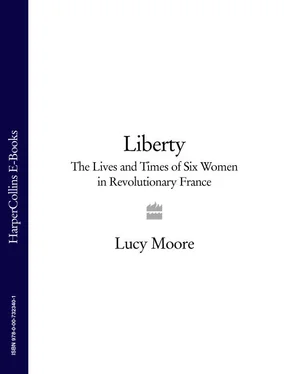A notable absence from the galleries on this imaginary afternoon was the former courtesan Théroigne de Méricourt, who before leaving Paris in the late summer of 1790 had been such a regular observer of the Assembly's sessions that she had her own seat reserved for her. She was known for always wearing a riding-habit of an austerely masculine cut, either in red, black or white. Although she had intended her trademark costume to compel men to treat her as an equal rather than as a woman, by wearing it she became one of the feminine icons of the revolution.
Abandoned by a faithless lover and reviled for having lost her reputation, Théroigne was very much alone in the world. She had suffered more at the hands of men than any of the other women here, and she was the most passionate and lonely campaigner for the liberties which the revolution seemed to promise women but ultimately failed to deliver. For nineteenth-century historians the image of pretty Théroigne in her red riding-habit, her bloody sword held aloft, represented all the savage excesses of the popular revolution; but this portrait of her bore very little relation to the earnest young woman whose early hopes were so disappointed by that revolution.
Another figure completes the sextet described in this book, but in the spring of 1791 Juliette Bernard, the future Madame Récamier, was still a bourgeois schoolgirl of thirteen, absorbed in studying English, Italian, dancing and the harp.
One further feminine image appears and reappears throughout these pages: not a real woman, but a constant, ghostly presence alongside her six flesh-and-blood sisters. Throughout this period Liberty—the ideal, or hope, that inspired the revolution—was represented as a goddess and exalted, pursued, manipulated and betrayed by turns.
The world of these six women, centred on Paris, was a small and intimate one. Less than six hundred thousand people lived in the capital in 1791 and their lives touched tangentially, crossed over without pausing and sometimes intersected. Respectable Manon Roland would never have received Théroigne de Méricourt at her salon, but one of her dearest friends fell hopelessly in love with her; Thérésia de Fontenay would not have known who Pauline Léon was, but before she met him her future husband gave a speech at a popular political club of which Léon was a member; despite the gap in their ages and backgrounds, Juliette Récamier would become one of Germaine de Staël's most intimate friends.
From the start, the revolution coloured every facet of their daily lives. It politicized everything, from clothing to modes of address to what was taught in schools to slang to food. Women, who had no direct influence over the political changes taking place around them, were intimately involved with these cultural changes; after all, they had read the same books and been inspired by the same ideas as their brothers. As the nineteenth-century historian Alexis de Tocqueville wrote of the period leading up to the revolution, even ‘women, amidst their petty household tasks, sometimes dreamed about the great problems of existence’. Many found that they were swept away by the exhilaration and optimism that infused French society, and became as absorbed by the revolution as their husbands and lovers.
The six women whose experiences form the basis of this book were each transformed by their experiences during the revolution. As Simon Schama writes in his book Citizens , the revolution ‘had the deepest craving for heroes’ embodying the abstract principles they were trying to make real. It also created heroines.
Although they came from a range of backgrounds and, like looking through different sides of a prism, each illuminates different aspects of the period—from the tomboy Pauline Léon with a brace of pistols tucked into her belt, haranguing the deputies of the National Convention, to the exquisite Juliette Récamier abandoning her inhibitions on the dance floors of the public balls during the Directory—these six women had in common courage, vitality, a youthful energy and a passion that marked the revolution as much as it marked them. Each of them, in her own way, burned to distinguish herself in the great drama unfolding in front of her.
1 SALONNIÈRE Germaine de Staël MAY–OCTOBER 1789
Mme de Staël's salon is more than a place where one meets for pleasure: it is a mirror in which we see reflected the image of the times.
ADAM DE CUSTINE
EVERY TUESDAY EVENING in the early years of the revolution, Germaine de Staël held a small dinner at her hôtel in the rue du Bac, on Paris's left bank. She invited a catholic assortment of liberal, anglophile nobles, their glamorous wives and mistresses, and ambitious young men of middling rank. ‘Go hence to Mme de Staël's,’ wrote Gouverneur Morris, the one-legged American envoy to Paris, in his apple-green journal in January 1791. ‘I meet here the world.’
For Germaine's guests, these evenings were a chance to discuss the latest news: books, plays, affairs and, above all, politics, the shared obsession of the day. Thomas Jefferson, a frequent visitor to the rue du Bac, called Paris in 1788 a ‘furnace of politics…men, women and children talk nothing else’. In the words of a foreign observer, the entire country felt ‘that they were on the eve of some great revolution’. For Germaine, her salons, combining her three passions–love, Paris and power—were ‘the noblest pleasure of which human nature is capable’.
‘We breathed more freely, there was more air in our lungs,’ she wrote of this optimistic period; ‘the limitless hope of infinite happiness had gripped the nation, as it takes hold of men in their youth, with illusion and without foresight’. If her friend the marquis de Talleyrand could say that no one who had not lived before 1789 could know the true sweetness of living, then Germaine could equally truly declare that for her, nothing could compare to the exquisite flavour of those days between 1788 and 1791 when she was in love and believed a new France was being created within the four gold-embroidered walls of her drawing-room.
Germaine de Staël was twenty-three in July 1789, the month that her father Jacques Necker, on-and-off Finance Minister to Louis XVI, was sacked by the king. Louis's powers permitted him to appoint, dismiss and banish ministers at will, so there was nothing unusual in this; what was unusual this time was the response it provoked.
Necker had made himself unpopular at court by advising the king to make wide-ranging changes to his archaic administration, urging modernization (particularly of the system of taxation, which weighed most heavily on the poor) and greater accountability to the French people. He had encouraged the king to summon the Estates-General, France's only national representative assembly, for the first time since 1614 and, partly at his daughter's urging, argued that the three estates (clergy, nobles and commons, known respectively as the First, Second and Third Estates) should vote individually -thus preventing the nobles and clergy from grouping together to block the Third Estate's demands.
Hard-line royalists, who feared the changes sweeping France, were convinced Necker would betray the king to his people, and welcomed his downfall. In the royal council, two days before Necker was dismissed, the king's brother, the comte d'Artois, told the minister to his face that he ought to be hanged; on the same day, in Paris, a well dressed woman was publicly spanked for spitting on his portrait.
Necker's defiant attitude towards the king had prompted his discharge and cemented his status as a popular hero; his reputation for financial acumen was matched only by his reputation for probity. Reformers who idolized him saw his expulsion as a manifestation of outmoded arbitrary power and an unwelcome confirmation of the king's distaste for reform. They rallied to the cause of their champion.
Читать дальше












